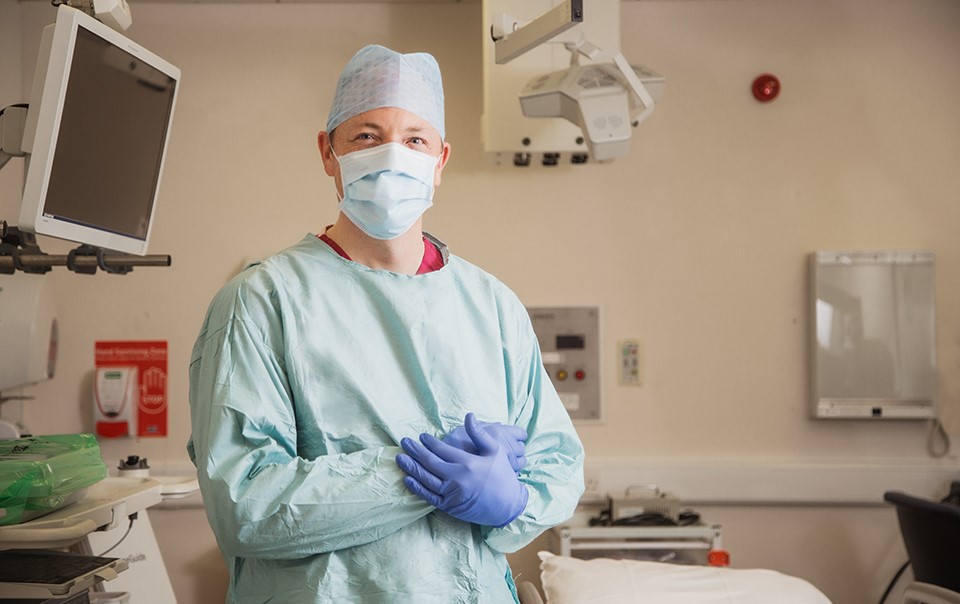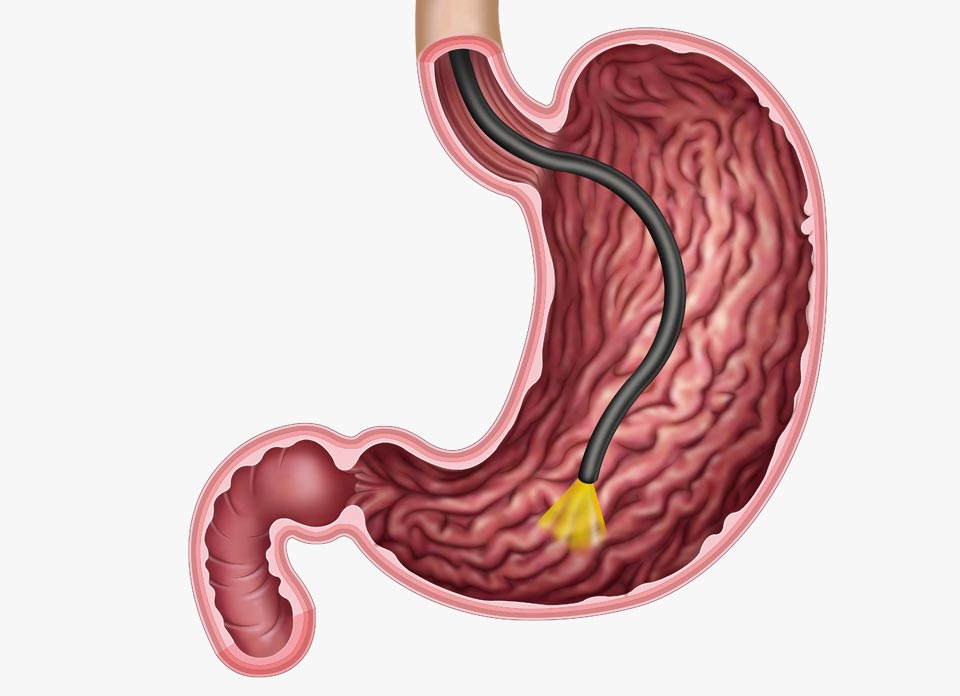 Gastroscopy
Gastroscopy
What is a gastroscopy?
The examination you will be having is called an oesophago-gastro-duodenoscopy (OGD), sometimes known more simply as a gastroscopy or endoscopy.
The examination is carried out by the specialist that you have chosen. You may choose to have either a sedative to help you relax during the examination or local anaesthetic throat spray to numb your throat.
This is an examination of your oesophagus (the tube that carries food from your mouth to your stomach), stomach and duodenum (the first part of your small bowel). The instrument used is called a gastroscope (scope). The gastroscope has a light which is shone onto the lining of your bowel. It also has a very small camera which sends a live image to a screen where it is viewed by the endoscopist.
During the examination the endoscopist may need to take some small tissue samples, called biopsies; this is painless. The samples will be looked at under a microscope in our laboratories.
Images from the gastroscopy will be kept in your health record.

Why do I need a gastroscopy?
You have been an advised to have gastroscopy to try and find the cause of your symptoms. The results will help your specialist to decide on the best treatment for your problem or whether we need to carry out any further examinations.
A gastroscopy may be advised for a number of reasons, including: indigestion, anaemia, losing weight without trying to, vomiting, blood in your stools, passing black stools, vomiting blood, difficulty swallowing, abdominal pain or a lump in your upper abdomen.

What are the alternatives?
A barium meal X-ray examination is an alternative examination. However, it is not as informative as an endoscopy and has the added disadvantage that tissue samples cannot be taken. If you would like to discuss this option, please speak to your specialist.
What are the risks?
A gastroscopy is a safe and simple examination for most people. Serious problems are rare, but life-threatening complications are possible. However, you need to weigh up the benefits against the risks of having the procedure. There can be risks from having the examination itself, as well as from the sedation. The main risks are
- A tear (perforation) in the lining of the stomach, esophagus or small bowel. This happens to approximately 1 in 2,000 people. It may be treated with antibiotics and intravenous fluids or may need surgery to repair the hole.
- Risk of a missed lesion - although gastroscopy has been selected as the best test to diagnose your symptoms, no test is perfect. There is a small risk that we might miss a lesion or other important finding during your test.
- Bleeding where we take a sample (biopsy) happens to about 1 in 150 people, but this is usually minor and often stops on its own.
- Short term problems with breathing, heart rate and blood pressure (related to sedation).
- We will monitor you carefully so that if any problems do occur, they can be treated quickly. Older people and those with significant health problems (for example, people with serious breathing difficulties) may be at higher risk.
- Damage caused by the endoscope to teeth or bridgework - this is very rare.
- Heart attack or stroke (related to sedation) - though this is very unlikely.
Sedation or throat spray?
A sedative injection can help you to relax during the gastroscopy if you are anxious. Local anaesthetic throat spray can improve your comfort during the examination. You will be offered the choice of sedation or local anaesthetic throat spray.
Sedation
The sedative is injected into a vein in your hand or arm and will make you lightly drowsy and relaxed but will not put you to sleep. You are likely to be aware of what is going on around you and will be able to follow simple instructions during the examination. We will monitor your breathing and heart rate throughout the examination.
If you have sedation you will not be allowed to drive home. You should also not go home alone on public transport. You must arrange for a family member or friend to collect you. The nurse will need to be given their telephone number so that we can contact them when you are ready to go home.
As the sedation can make you drowsy and unsteady on your feet, we also recommend that you have someone responsible to stay with you overnight after the procedure.
Anaesthetic throat spray
This spray numbs your throat with a local anaesthetic - this has an effect very much like a dental injection. As gastroscopes have become thinner, many people are happy for the examination to be carried out without sedation and to have throat spray instead.
The benefit of choosing throat spray is that you will remain fully conscious and aware and can go home unaccompanied soon after the examination. You will be allowed to drive and can carry on life as normal. The only constraint is that you must not have anything to eat or drink for about an hour after the examination, until the sensation in your mouth and throat has returned to normal. It is strongly advised that when having your first drink after the examination, it should be a cold drink and should be sipped to make sure you do not choke.
Preparation
Eating and drinking
You must not eat anything for six hours before your gastroscopy. This is because food can stop the endoscopist getting a clear view of the inside of your stomach. It also increases the risk of inhaling (breathing in) the contents of your stomach into your lungs, which can cause severe pneumonia. You can have sips of water up to two hours before your test. If you do eat something, your test will be cancelled.
What do I need to bring with me?
Please leave all valuables at home. The hospital cannot accept responsibility for these items.
What about my medicines?
You should continue to take your routine medicines.
Patients with diabetes
If you have diabetes controlled by insulin or tablets, please make sure that you tell us so that we can give you an appointment at the beginning of the morning or afternoon.
What happens when I arrive at the Endoscopy Unit?
Soon after you arrive you will be reviewed or seen by a nurse who will ask you a few questions about your medical condition and any past surgery or illness you have had. This is to confirm that you are fit enough to undergo the gastroscopy examination. The nurse will record your heart rate, blood pressure and oxygen levels. If you are diabetic, your blood glucose level will also be recorded.
The nurse will also make sure you understand the examination and you will be able to ask any further questions or raise any concerns you may have. The nurse will also ask you about your arrangements for getting home after your gastroscopy. If you have decided to have a sedative, you must be accompanied home.
How long will I be in the endoscopy department?
This depends upon whether you have sedation and also how busy the department is. You should expect to be in the department for most of the morning or afternoon. The department also deals with emergencies which can take priority over outpatient appointments. However, we will try to keep any delays to a minimum.
What happens during the gastroscopy examination?
You will be escorted into the examination room where the endoscopist and the nurses will introduce themselves and you will have the opportunity to ask any final questions. If you are having local anaesthetic throat spray, this will be sprayed onto the back of your throat whilst you are sitting up. You will quickly notice a loss of sensation to your tongue and throat. You will be given a small plastic mouth guard to put between your teeth to protect them during the examination. If you have any dentures you will be asked to remove them first.
The nurse looking after you will then ask you to lie on the trolley on your left side and will place a probe on your finger to monitor your oxygen levels. If you have decided to have a sedative this will be injected at this point into a vein and you will quickly become sleepy. A small suction tube, rather like the one used at the dentist, will be used to remove any saliva or other secretions produced by your mouth during the examination.
The endoscopist will put the gastroscope into your mouth and ask you to swallow. The endoscopist will then insert the gastroscope gently down your oesophagus into your stomach and on into your duodenum. You will be able to breathe normally through your nose. A small amount of air will be blown into your stomach to help the endoscopist to see clearly. This may be uncomfortable but shouldn't cause any pain.
After the examination
If you have been sedated, we will ask you to rest for up to an hour. Your blood pressure, heart rate and breathing will be monitored. If you are diabetic, your blood glucose will also be monitored. Once you have recovered from the initial effects of any sedation you will be offered a drink and a biscuit. You should not have any pain Before you leave the department, a nurse or the endoscopist will explain the results of the examination and whether you need further appointments, If you have not had a sedative you will be able to go home or back to work soon after the gastroscopy. You will be given a copy of your gastroscopy report.
If you have had a sedative, it can make you forgetful and drowsy for up 24 hours after the examination. It is a good idea to have a member of your family or a friend with you when you are given the findings of your examination, just in case you don't remember everything we are telling you. If you live alone, we recommend that you arrange for someone to stay with you overnight
For 24 hours after the sedation you must not:
- drive
- take alcohol
- operate heavy machinery
- sign any legally binding documents.
Most people feel perfectly back to normal after 24 hours.
After you go home
If you have any problems with a persistent sore throat, or worsening chest or abdominal pain during the next 48 hours after your gastroscopy, please contact the endoscopy unit where you had your procedure.
